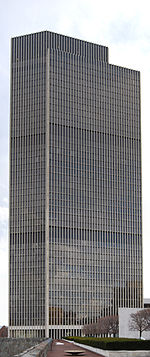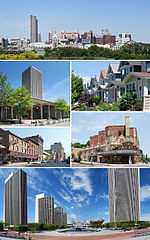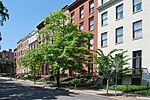The Egg, Albany

The Egg is a performing arts venue in Albany, New York. Named for its shape, the building was designed by Harrison & Abramovitz as part of the Empire State Plaza project, and built between 1966 and 1978. It is located in the northeast corner of the Plaza. It has become an icon of New York's Capital District due to its unusual shape and central location. The Egg is owned by the state of New York and managed by the Nelson A. Rockefeller Empire State Plaza Performing Arts Center Corporation a not-for-profit that was created in 1979 to manage the performing arts facility in the Empire State Plaza. The Ellen Sinopoli Dance Company, a modern dance performing arts group, has been the resident company at the Egg for 28 years. The Egg is the summer home of the Ajkun Ballet Theatre, a New York City based professional company, since the year 2000
Excerpt from the Wikipedia article The Egg, Albany (License: CC BY-SA 3.0, Authors, Images).The Egg, Albany
Eagle Street, City of Albany
Geographical coordinates (GPS) Address Nearby Places Show on map
Geographical coordinates (GPS)
| Latitude | Longitude |
|---|---|
| N 42.6505 ° | E -73.7584 ° |
Address
Empire State Plaza (Governor Nelson A. Rockefeller Empire State Plaza)
Eagle Street
12234 City of Albany
New York, United States
Open on Google Maps










